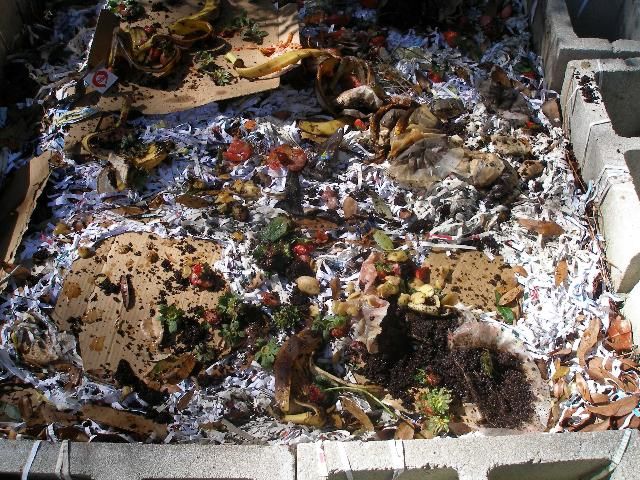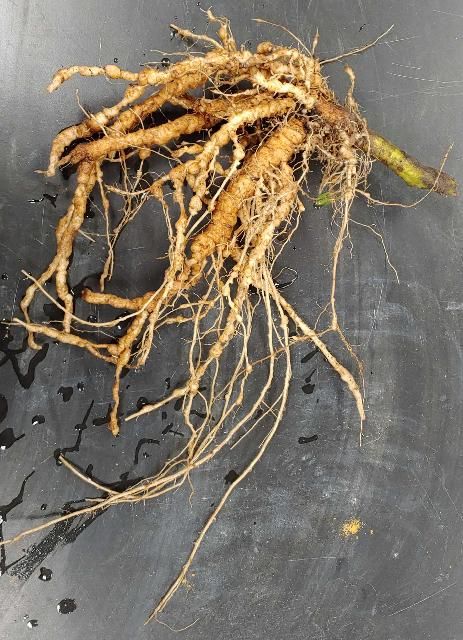Much of the soil in Florida is very sandy and has very little organic matter. Vegetables, flowers, and landscape plants grown in soil that is high in organic matter often are less damaged by nematodes than plants grown in soil with less organic matter content. Any kind of organic soil amendment, including compost, green manures, and lightly incorporated organic mulches, can have this effect. Organic amendments can both improve tolerance of the plant to nematodes and also reduce nematode populations. However, they cannot magically eliminate a severe nematode infestation overnight. They are better suited to keeping nematode populations relatively low than reducing high ones. There are several ways in which organic soil amendments may help reduce nematode injury to plants.
Soil Organic Matter
Soil organic matter is any material in the soil that was originally produced by living organisms. At any given time, it consists of a range of materials varying from intact plant material to the substantially decomposed organic materials known as humus. Plant tissues contain a wide range of organic compounds, which typically decompose at different rates.
Adding fresh plant material to a soil which has little or no readily decomposable materials immediately starts rapid multiplication of bacteria, fungi, and other microorganisms, which actively decompose the fresh tissue. As the most readily available energy sources (carbohydrates, fats, proteins) in the fresh material are used up, those microorganisms again become relatively inactive.
Most plant-parasitic nematodes feed on and damage plant roots (Figure 2). Many of the negative affects from nematodes are due to the inability of nematode-damaged roots to obtain water and nutrients from soil. Thoroughly decomposed organic matter (called humus) improves soil texture and the ability of soil to retain water and many plant nutrients. Because humus improves the ability of soil to hold onto water and nutrients, it gives plants more opportunity to obtain them. This is how organic amendments improve plant tolerance to nematodes. Additionally, humus promotes better soil structure by causing soil to stick together, and it provides some nutrients as it is slowly decayed by microbial activity. Mulches of organic materials that help keep roots cool and reduce evaporation from soil also help reduce stress, and add humus as they decompose.

Credit: William T. Crow, UF/IFAS

Credit: Zane Grabau, UF/IFAS
Adding Organic Matter to Soil
There are several ways to add organic matter to soil including:
- compost—organic material that has been substantially decomposed under somewhat controlled conditions, so that most of the readily exploited nutrients are exhausted
- noncomposted plant and animal material—common examples are leaves and garden waste, or fresh animal manure
- green manure—fresh plant material grown purposely to be incorporated into the soil on the site where it was grown.
Compost
Compost provides many of the nutrients plants need and will be converted into humus. Because the readily available nutrients are mostly consumed in the composting process, compost will not stimulate microbial activity to the same degree as fresh plant tissue.
Fresh Organic Matter
Whole plants, green grass clippings and leaves, or fresh animal manures can add organic matter to soil. Material so added can help maintain or raise the organic matter content of the soil, and thus its ability to produce crops, in several ways.
Whole, but Not Fresh, Organic Matter
Dry plant materials like wood chips, saw dust, peanut hulls, or pine straw typically need moisture to be added for decomposition to proceed. Because nutrients like nitrogen are typically lacking in these materials, they break down much more slowly than fresh organic matter. Also, soil nutrients may be tied up by microbes attempting to break down these types of materials. Therefore, mixing dry organic materials with the fresh organic matter defined above and/or composting prior to use is generally recommended before using them as a soil amendment.
Green Manure
Green manuring (discussed in detail below) is turning under of a green crop to better the condition of the soil. Material so added, if soil is in proper condition and well managed, can help maintain or raise the organic matter content of the soil, and thus its ability to produce crops, in several ways.
Soil Biological Activity
Decomposing organic matter is food for many soil microbes (fungi, actinomycetes, and bacteria). Some of those creatures are natural enemies of plant nematodes; increasing their numbers enhances "natural" nematode control.
Chemical By-Products
Decomposition of some organic amendments, including some green manures, oily plant residues such as cottonseed meal, or meal from certain types of mustard have been shown to release chemicals that are directly toxic to nematodes. Those chemicals may reduce nematode numbers directly in addition to the other benefits derived from soil organic amendments.
"Nematicidal" Miracle Products
Claims of nematode control are made for many products sold as soil amendments and additives, but objective research data rarely accompany those claims. Research conducted at University of Florida has found most of these do not suppress nematodes any more than the much cheaper organic amendments discussed previously. If a product's claims cannot be supported with evidence from well-designed research, preferably conducted by scientists who are in no way connected with the product, be very cautious about depending on it for nematode control.
Green Manures
Green manuring is the practice of growing plants on the site into which you wish to incorporate organic matter, then turning (tilling, plowing, spading) it into the soil while it is still fresh. The plant material used in this way is called a green manure. The plant material may or may not be cut free from its roots before being incorporated into the soil, depending on what is needed to be able to handle it. Green manuring is popular among organic gardeners and farmers; it is also used by some conventional growers who recognize its benefits. It is widely adopted simply because adding large amounts of green plant material benefits many soil characteristics, including drainage and water retention, nutrient content and form of storage, and level of microbiological activity in the soil.
- Green manuring supplies soil organic matter, as already discussed.
- It can conserve or even add nutrients. Nitrogen used by the green manure crop has been protected from leaching loss and microbial degradation that could take place if the land were left fallow. Other nutrients such as potassium, phosphorus, magnesium, and iron can be similarly conserved through green manuring. Using a legume can increase soil nitrogen levels through N fixation by the Rhizobium bacteria associated with most legume roots.
- Microbiological benefits—there is a substantial increase in activity of soil fungi and bacteria that do many useful things. Generally, the more diverse and greater the soil microbial population, the more productive the soil will be.
- Conservation of topsoil against loss by erosion can be a substantial nutrient conservation benefit of green manuring.
Green manuring has also been demonstrated to reduce levels of nematodes in the soil in some cases, in addition to reducing the amount of damage due to nematodes feeding on plant roots.
To be useful as a green manure, a plant should: 1) grow rapidly; 2) produce abundant and succulent tops; 3) grow well in the conditions of the site. The higher the moisture content of the material, the more rapidly it will break down and its benefits be realized. When other conditions are equal, it is better to use a legume because of the nitrogen fixation and the microbial activity it promotes.
Crops that are selected for use as green manures are usually chosen for their ability to grow very rapidly and produce a large mass of top growth at the season and site. Cool season grasses are often used in Florida for fall and winter green manure crops; legumes are often desirable because they naturally convert nitrogen from the air into plant nutrients, thus increasing the levels of that most critical nutrient in the soil when the plant tissues are incorporated into the soil.
It is generally best to turn green crops under when their succulence is near the maximum, yet when enough top growth has been produced. Usually this is before flowering.
If a "nematicidal" crop such as those discussed below can be used as a green manure, it may have an even greater effect on nematodes in the soil by beginning their reduction as a cover crop before it is turned into the soil. For instance, hairy indigo is valuable in both ways in north and central Florida.
Risks in Green Manuring
Take care to avoid planting green manure crops that can encourage reproduction of nematodes, especially root-knot nematodes. Increasing a nematode population on a green manure crop can offset all benefits that would otherwise be gained. If at all possible, choose crops for green manuring that are known to inhibit root-knot nematodes.
"Nematicidal" Cover Crops
Several plants have been found to help control some kinds of nematodes when grown for several months in soil where they are present, if no good hosts of those nematode species are present. These plants may reduce nematode populations significantly more than fallowing or growing a crop on which the nematodes do not feed. Control sometimes equals that from chemical treatments. In other words, using these plants as cover crops may significantly reduce nematode injury to susceptible crops grown in the next season. They rarely, if ever, protect plants from nematodes when planted among or beside them (companion planting or interplanting) under field conditions in Florida. A few plants known to help reduce important nematode pests in Florida are listed in Table 1.
Cover crops that may be useful in managing common plant parasitic nematodes in Florida gardens. Yes = should reduce nematode populations. No = might increase nematode populations. Depends = some varieties are resistant, others are susceptible; see "more detailed information" for variety-specific information.